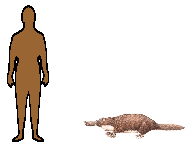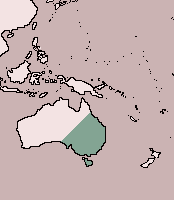Platypus

| Class: Mammalia:
Mammals |
Diet: Crustaceans |
| Order:
Monotremata: Monotremes |
| Size: 140
- 175 cm (55 - 69 in) |
| Family: Ornithorhynchidae:
Platypus |
Conservation Status:
Near Threatened |
| Scientific Name:
Ornithorhynchus anatinus |
Habitat: lakes, rivers |
| Range:
Eastern Australia, Tasmania |
 The
platypus is a semiaquatic animal, and many of its physical characteristics
are adaptations for its life as a fresh-water predator. Its legs are short
but powerful, and the feet are webbed, though the digits retain large claws,
useful for burrowing. On the forefeet the webs extend beyond the claws
and make efficient paddles; on land, the webs can be folded back to free
the claws for digging. On each ankle the male platypus has a spur connected
to poison glands in the thighs; these spurs are used against an attacker
or against a competing platypus but never against prey. The poison is not
fatal to man but causes intense pain. The platypus's eye and ear
openings lie in furrows which are closed off by folds of skin when the
animal is submerged. Thus, when hunting underwater, the platypus relies
on the sensitivity of its tactile, leathery bill to find prey. The nostrils
are toward the end of the upper bill but can only function when the head
is in air. Young platypuses have teeth, but adults have horny, ridged plates
on both sides of the jaws for crushing prey. The
platypus is a semiaquatic animal, and many of its physical characteristics
are adaptations for its life as a fresh-water predator. Its legs are short
but powerful, and the feet are webbed, though the digits retain large claws,
useful for burrowing. On the forefeet the webs extend beyond the claws
and make efficient paddles; on land, the webs can be folded back to free
the claws for digging. On each ankle the male platypus has a spur connected
to poison glands in the thighs; these spurs are used against an attacker
or against a competing platypus but never against prey. The poison is not
fatal to man but causes intense pain. The platypus's eye and ear
openings lie in furrows which are closed off by folds of skin when the
animal is submerged. Thus, when hunting underwater, the platypus relies
on the sensitivity of its tactile, leathery bill to find prey. The nostrils
are toward the end of the upper bill but can only function when the head
is in air. Young platypuses have teeth, but adults have horny, ridged plates
on both sides of the jaws for crushing prey.
 The
platypus feeds mainly at the bottom of the water, making dives lasting
a minute or more to probe the mud with its bill for crustaceans, aquatic
insects and larvae. It also feeds on frogs and other small animals and
on some plants. Platypuses have huge appetites, consuming up to 1 kg (2
1/4 lb) of food each night. Short burrows dug in the riverbank above
the water level are used by the platypus for refuge or during periods of
cool weather. In the breeding season, however, the female digs a burrow
12 m (40 ft) or more in length, at the end of which she lays her 2 or 3
eggs on a nest of dry grass and leaves; the rubbery eggs are cemented together
in a raft. She plugs the entrance to the burrow with moist plant matter,
and this prevents the eggs from drying out during the 7-to 14-day incubation
period. When the young hatch, they are only about 1.25 cm (1/2 in) long
and helpless. Until they are about 5 months old, they feed on milk, which
issues from slits in the mother's abdominal wall. Unlike spiny anteaters,
they do not draw up tucks of skin into pseudonipples but lap and suck the
milk off their mother's abdominal fur. The
platypus feeds mainly at the bottom of the water, making dives lasting
a minute or more to probe the mud with its bill for crustaceans, aquatic
insects and larvae. It also feeds on frogs and other small animals and
on some plants. Platypuses have huge appetites, consuming up to 1 kg (2
1/4 lb) of food each night. Short burrows dug in the riverbank above
the water level are used by the platypus for refuge or during periods of
cool weather. In the breeding season, however, the female digs a burrow
12 m (40 ft) or more in length, at the end of which she lays her 2 or 3
eggs on a nest of dry grass and leaves; the rubbery eggs are cemented together
in a raft. She plugs the entrance to the burrow with moist plant matter,
and this prevents the eggs from drying out during the 7-to 14-day incubation
period. When the young hatch, they are only about 1.25 cm (1/2 in) long
and helpless. Until they are about 5 months old, they feed on milk, which
issues from slits in the mother's abdominal wall. Unlike spiny anteaters,
they do not draw up tucks of skin into pseudonipples but lap and suck the
milk off their mother's abdominal fur.
  
|

